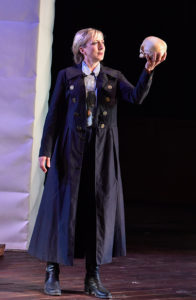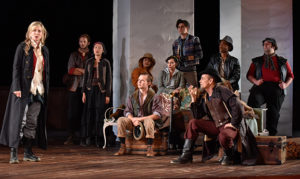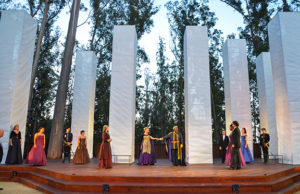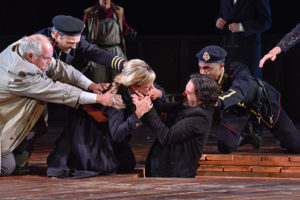A Woman in the Lead: A Review of HAMLET at Santa Cruz Shakespeare
August 26, 2016 § Leave a Comment
At Santa Cruz Shakespeare Kate Eastwood Norris is not only a woman playing Hamlet, she is playing Hamlet as a woman – and the result is every bit as wonderful (in an especially Santa Cruz-ish way) as you might expect.

Kate Eastwood Norris (Hamlet) in Santa Cruz Shakespeare’s 2016 production of Hamlet 2016. Photo by Jana Marcus.
Although a woman playing the role of Hamlet is not nearly as rare in theatre history as most would suppose, or even unique to the San Francisco Bay Area this season (given Shotgun Players’ conceptually fascinating Hamlet roulette which randomly selects a women for the role in about half of its performances) Ms. Norris in the title role at Santa Cruz Shakespeare is notable for a number of reasons. First, she is genuinely good in the part. Second, she debuted in the part the same night that Hillary Clinton became the first woman nominee of a major party for President of the United States and the historic resonance with the audience was palpable. Most of all, however, what makes this casting particularly interesting is that it is situated within a production that genderbends a number of roles in ways that illuminate the play anew.
Gender Equity In Action
This is the second season in which Artistic Director Mike Ryan has pursued a policy of gender equity in casting. This is no mean feat, since Shakespeare’s plays do not feature anything like equal balance of male and female characters. Most companies that are trying to address this concern (not nearly enough) do so by pursuing what is known as “gender-blind” casting, wherein women are cast in male gendered parts but the convention is that the underlying gender of the actor is irrelevant and essentially ignored. Others do so by “conceptual casting,” in which women simultaneously “play” and “comment on” their characters. In this case, the female interpretation of the male role becomes the major interest. This tends to be especially true of all-female productions.
Ryan has consistently taken a different tack. At SCS, the roles have been regendered to match that of the actors playing them. In this production, not just Hamlet, but also Polonius, Rosencrantz, Guildenstern and Francisco all become female characters. (Unsurprisingly, from the point of parity, no gender bending moved characters from female to male, but – at least in the case of Ophelia – this still had interesting consequences.) Although it is the sort of change that makes purists blanch because it alters the play in some fundamental ways, it also provides new perspectives on often overly familiar literature that can (when well done) make it a totally new experience. This has become the house style at SCS concerning gender, although the company (or at least its predecessor company, Shakespeare Santa Cruz) has long practiced color-blind casting, as it does in this production.
Director Paul Mullins* handled this reframing of the play with exceptional skill and succeeds in helping us rethink this masterpiece. (His staging is beautiful, and his pacing and shaping of the performance masterful but it is his interpretive skills that set him apart here.)

Kate Eastwood Norris (Hamlet) and Larry Paulson (Player King) and the other Players in Paul Mullins’ beautiful staging. Photo by Jana Marcus.
Visuals
Collette Pollard’s set for this outdoor venue is a large neutral space punctuated with seven tall white columns. (Kent Dorsey’s lights made little impression in the bright afternoon sun at the matinee I attended, but might be a totally different experience during evening performances.) B. Modern’s eclectic costumes feature everything from plaid-skirted schoolgirls to medieval robes, but largely settle into a vaguely Edwardian look. It is a kind of alternate Edwardian universe, however, where same-sex marriage is so routine that the possibility raises no eyebrows. Proudly liberal Santa Cruz has, apparently, always been Santa Cruz. (Except for pronouns, no lines were changed in this version to reflect the gender-bending. Even Hamlet’s extremely hetero-normative “Will thou be a breeder of sinners?” survived the editor’s red pen, although it no longer seems a logical concern.)

Set by Collette Pollard. Costumes by B. Modern
Which Hamlet?
For ardent Shakespeareans, the “insider baseball” for any production of Hamlet is which Hamlet we see. The text exists in three vastly different Renaissance versions. Two of them get most of the attention. The so called “Second Quarto” of 1604, and the First Folio of 1623 differ in length by some 150 full lines. Q2 contains an entire soliloquy that is cut from the Folio, and there are hundreds of minor wording changes. This production cut a good deal of the text, with some interesting minor rearrangements here and there, but generally followed the Folio version.
It is the third alternative that can provide, continuing our baseball metaphor, the real curveball. The “First Quarto” of 1603 is a bizarre text, half the length of the others and featuring what almost sounds like a paraphrase of the text to which we are accustomed. Most scholars believe that it is a version of the text put together from memory by actors, observers (or both) without consulting a written manuscript.
However odd it is, and Q1 is really odd, it has a few interesting features which might relate to it being pieced together after watching an actual performance. Most significantly, the scenes are in a different order. The most famous soliloquy in the canon, “To be or not to be,” sits at the start of Act II instead of the beginning of Act III.
Santa Cruz performs the piece in Q1 order, although it utilizes the wording from the F1 text. This makes a world of difference. Hamlet becomes far less indecisive and confused. In the typical order, Hamlet confirms his uncle’s treachery through a performance of a play-within-the-play that replicates the conditions of his murder of Hamlet’s father. He seems overjoyed at this, but in the very next scene he returns with his famous contemplation of suicide. Modern actors go through all kinds of psychological twists to make sense of this bizarre emotional reversal.
In Q1 order, however, (as performed at Santa Cruz) Hamlet is suicidal when she is not sure whether her father is a truthful ghost or a deceiving demon, but snaps back out of this depression once the playlet reveals the truth and never wavers thereafter. This is not only sensible, but thrilling. Eastwood Norris’ Hamlet is far stronger than that of most men I have seen play the role, flirting with madness to a far smaller degree, which is largely because of her own laser-like focus, but the less confusing order of events also propels her forward in a manner that is more palpably immediate and less intellectually abstract.

Mike Ryan (Horatio), Kyle Hester (Marcellus), Kate Eastwood Norris (Hamlet), Cody Nickell (Laertes), and Christian Strange (Barnardo) in Santa Cruz Shakespeare’s 2016 production of Hamlet 2016. Photo by Jana Marcus.
Performances of Note
The production features a number of very notable performances. Bernard K. Addison plays both the ghostly King Hamlet and the villainous King Claudius. Cody Nickell has the unenviable task of finding a way to keep the complexity in Laertes’ character, although an awful lot of social conditioning teaches us that someone who would plot the death of a woman (as Hamlet is in this case) is not just duplicitous but also a bully. Even viewed through that lens, however, he finds the redeeming humanity in the character. Mike Ryan is a solid and precise Horatio.
Patty Gallagher (a performer whose work I consistently admire) brings a pathetic depth to Polonius that I have rarely seen. She seems less a silly old fool than a woman who is hopelessly double-bound by the responsibilities she is given and the disempowering standards of behavior to which she is held (restricted?) while trying to achieve them. Although Eastwood Norris’ Hamlet provided a very interesting resonance in the shadow of Hillary Clinton’s achievement, Gallagher’s Polonius was equally reminiscent in another way as we saw and judged her quite differently than we would a man in the same situation.
Mary Cavett as Rosencrantz and Katherine Ko as Guildenstern are guileless schoolgirls, clearly out of their depth. In this one case, I worried about the difference casting women in the roles made. It was not their performances, which were impeccable, but the context. When I learned (spoiler alert) that Hamlet had substituted an order than ended with their execution, Hamlet’s declaration that “they come not near my conscious” proved the least sympathetic moment of the evening – a touch of calculated cruelty that made me cringe, and made me think about why it felt so different from how this moment usually plays.
See This Production? Absolutely!
Ryan’s leadership of SCS is brave, and in this case, Director Mullins delivered on his mandate and made a female Hamlet feel both inevitable and historic at once.
*Although we have not seen each other since, full disclosure is that Mullins was a classmate of mine in the Professional Theatre Training Program at Southern Methodist University in the early ’80s.
Leave a Reply